Corporate Law Assignment: Constitution, Shareholders and Directors
VerifiedAdded on 2023/06/07
|10
|2594
|106
Report
AI Summary
This report provides an in-depth analysis of company constitutions under Australian corporate law. It examines the role and purpose of a company's constitution, including its function in governing the actions of directors and shareholders, and establishing contractual relationships within the company. The report references key sections of the Corporations Act 2001 (Cth) regarding company constitutions, amendments, and the rights of both majority and minority shareholders. It explores the process of amending a constitution via special resolutions and addresses the limitations placed on the power of majority shareholders to protect the interests of minority members. The report also discusses relevant case law, such as Salomon v Salomon & Co Ltd, Lee v Lee's Air Farming Ltd, Gambotto v WCP Ltd, and others, to illustrate the application of legal principles. Overall, the report assesses the effectiveness of existing legal protections for minority shareholders and the limitations on majority shareholder powers, concluding with a discussion of proper and improper purposes for amending a company constitution.
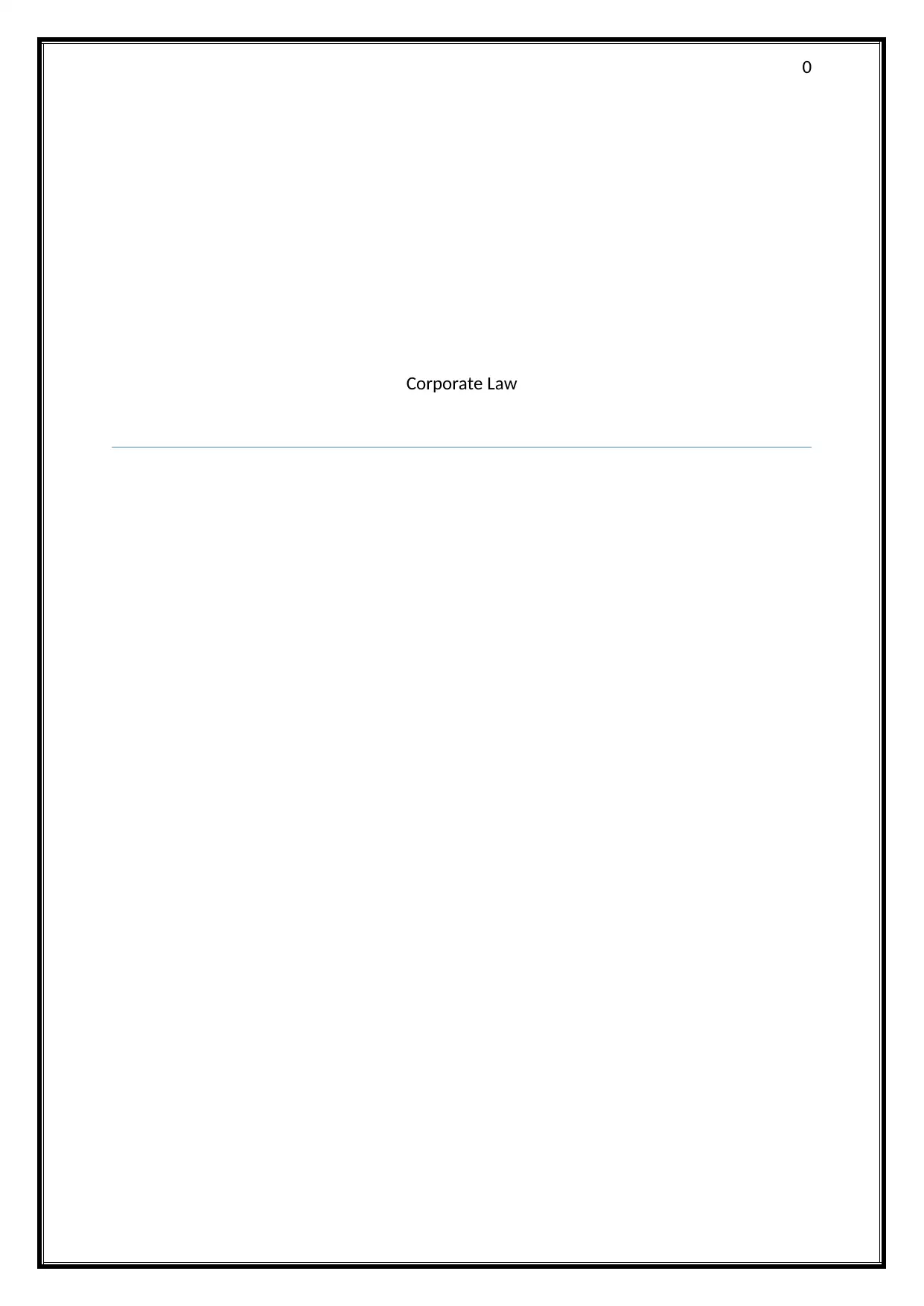
0
Corporate Law
Corporate Law
Paraphrase This Document
Need a fresh take? Get an instant paraphrase of this document with our AI Paraphraser
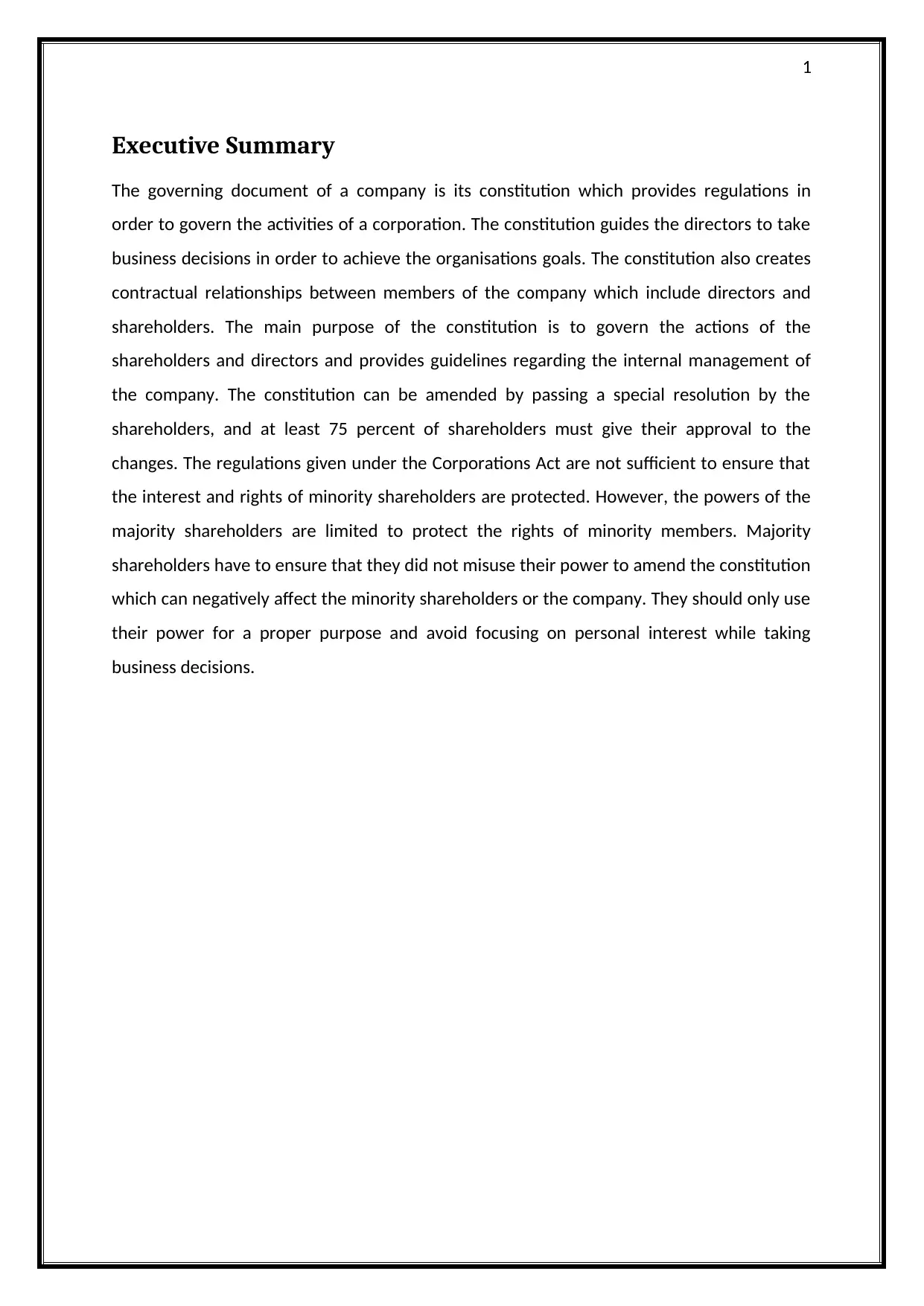
1
Executive Summary
The governing document of a company is its constitution which provides regulations in
order to govern the activities of a corporation. The constitution guides the directors to take
business decisions in order to achieve the organisations goals. The constitution also creates
contractual relationships between members of the company which include directors and
shareholders. The main purpose of the constitution is to govern the actions of the
shareholders and directors and provides guidelines regarding the internal management of
the company. The constitution can be amended by passing a special resolution by the
shareholders, and at least 75 percent of shareholders must give their approval to the
changes. The regulations given under the Corporations Act are not sufficient to ensure that
the interest and rights of minority shareholders are protected. However, the powers of the
majority shareholders are limited to protect the rights of minority members. Majority
shareholders have to ensure that they did not misuse their power to amend the constitution
which can negatively affect the minority shareholders or the company. They should only use
their power for a proper purpose and avoid focusing on personal interest while taking
business decisions.
Executive Summary
The governing document of a company is its constitution which provides regulations in
order to govern the activities of a corporation. The constitution guides the directors to take
business decisions in order to achieve the organisations goals. The constitution also creates
contractual relationships between members of the company which include directors and
shareholders. The main purpose of the constitution is to govern the actions of the
shareholders and directors and provides guidelines regarding the internal management of
the company. The constitution can be amended by passing a special resolution by the
shareholders, and at least 75 percent of shareholders must give their approval to the
changes. The regulations given under the Corporations Act are not sufficient to ensure that
the interest and rights of minority shareholders are protected. However, the powers of the
majority shareholders are limited to protect the rights of minority members. Majority
shareholders have to ensure that they did not misuse their power to amend the constitution
which can negatively affect the minority shareholders or the company. They should only use
their power for a proper purpose and avoid focusing on personal interest while taking
business decisions.

2
Table of Contents
Answer 1.....................................................................................................................................3
Answer 2.....................................................................................................................................4
Answer 3.....................................................................................................................................5
References..................................................................................................................................7
Table of Contents
Answer 1.....................................................................................................................................3
Answer 2.....................................................................................................................................4
Answer 3.....................................................................................................................................5
References..................................................................................................................................7
⊘ This is a preview!⊘
Do you want full access?
Subscribe today to unlock all pages.

Trusted by 1+ million students worldwide
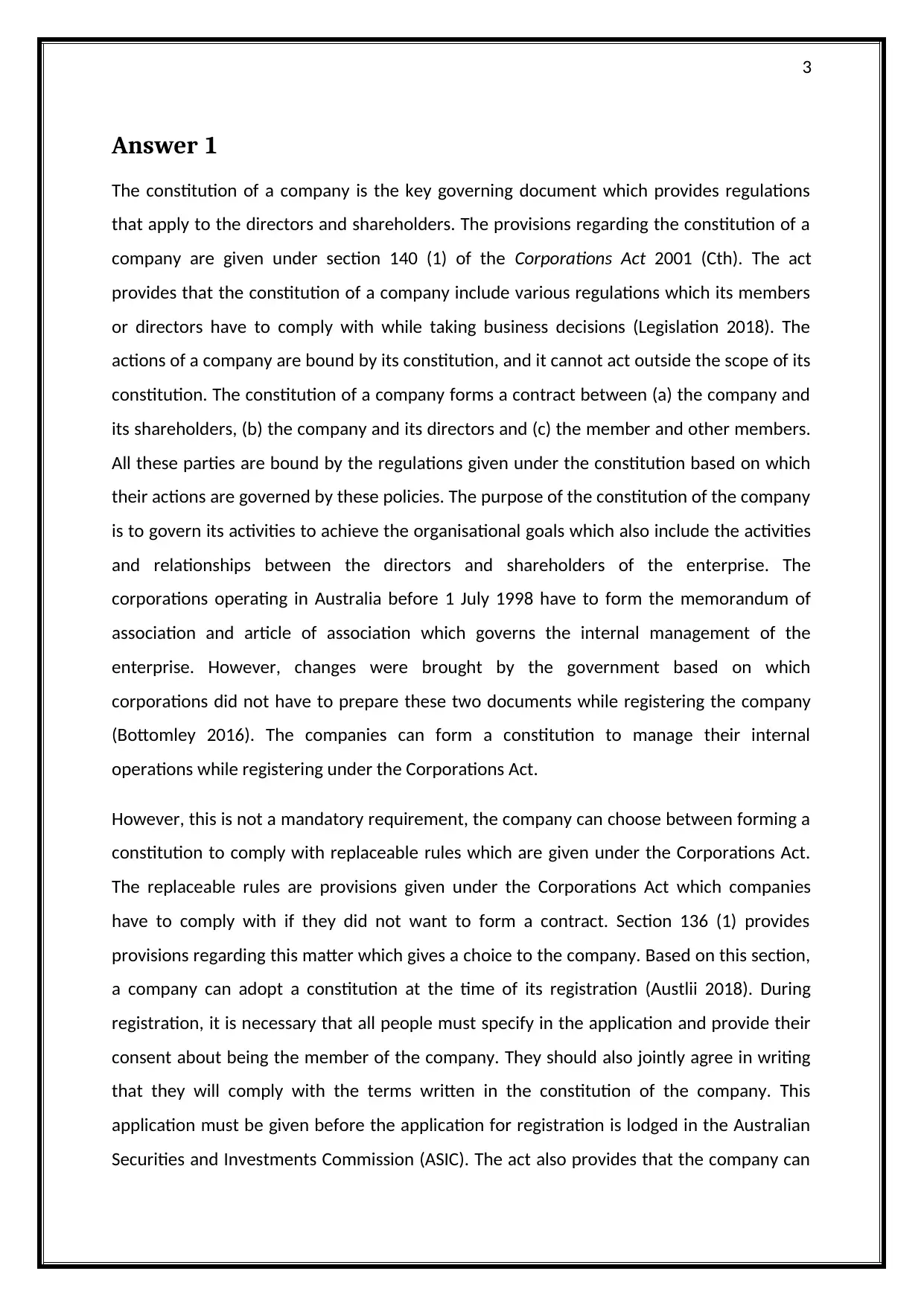
3
Answer 1
The constitution of a company is the key governing document which provides regulations
that apply to the directors and shareholders. The provisions regarding the constitution of a
company are given under section 140 (1) of the Corporations Act 2001 (Cth). The act
provides that the constitution of a company include various regulations which its members
or directors have to comply with while taking business decisions (Legislation 2018). The
actions of a company are bound by its constitution, and it cannot act outside the scope of its
constitution. The constitution of a company forms a contract between (a) the company and
its shareholders, (b) the company and its directors and (c) the member and other members.
All these parties are bound by the regulations given under the constitution based on which
their actions are governed by these policies. The purpose of the constitution of the company
is to govern its activities to achieve the organisational goals which also include the activities
and relationships between the directors and shareholders of the enterprise. The
corporations operating in Australia before 1 July 1998 have to form the memorandum of
association and article of association which governs the internal management of the
enterprise. However, changes were brought by the government based on which
corporations did not have to prepare these two documents while registering the company
(Bottomley 2016). The companies can form a constitution to manage their internal
operations while registering under the Corporations Act.
However, this is not a mandatory requirement, the company can choose between forming a
constitution to comply with replaceable rules which are given under the Corporations Act.
The replaceable rules are provisions given under the Corporations Act which companies
have to comply with if they did not want to form a contract. Section 136 (1) provides
provisions regarding this matter which gives a choice to the company. Based on this section,
a company can adopt a constitution at the time of its registration (Austlii 2018). During
registration, it is necessary that all people must specify in the application and provide their
consent about being the member of the company. They should also jointly agree in writing
that they will comply with the terms written in the constitution of the company. This
application must be given before the application for registration is lodged in the Australian
Securities and Investments Commission (ASIC). The act also provides that the company can
Answer 1
The constitution of a company is the key governing document which provides regulations
that apply to the directors and shareholders. The provisions regarding the constitution of a
company are given under section 140 (1) of the Corporations Act 2001 (Cth). The act
provides that the constitution of a company include various regulations which its members
or directors have to comply with while taking business decisions (Legislation 2018). The
actions of a company are bound by its constitution, and it cannot act outside the scope of its
constitution. The constitution of a company forms a contract between (a) the company and
its shareholders, (b) the company and its directors and (c) the member and other members.
All these parties are bound by the regulations given under the constitution based on which
their actions are governed by these policies. The purpose of the constitution of the company
is to govern its activities to achieve the organisational goals which also include the activities
and relationships between the directors and shareholders of the enterprise. The
corporations operating in Australia before 1 July 1998 have to form the memorandum of
association and article of association which governs the internal management of the
enterprise. However, changes were brought by the government based on which
corporations did not have to prepare these two documents while registering the company
(Bottomley 2016). The companies can form a constitution to manage their internal
operations while registering under the Corporations Act.
However, this is not a mandatory requirement, the company can choose between forming a
constitution to comply with replaceable rules which are given under the Corporations Act.
The replaceable rules are provisions given under the Corporations Act which companies
have to comply with if they did not want to form a contract. Section 136 (1) provides
provisions regarding this matter which gives a choice to the company. Based on this section,
a company can adopt a constitution at the time of its registration (Austlii 2018). During
registration, it is necessary that all people must specify in the application and provide their
consent about being the member of the company. They should also jointly agree in writing
that they will comply with the terms written in the constitution of the company. This
application must be given before the application for registration is lodged in the Australian
Securities and Investments Commission (ASIC). The act also provides that the company can
Paraphrase This Document
Need a fresh take? Get an instant paraphrase of this document with our AI Paraphraser
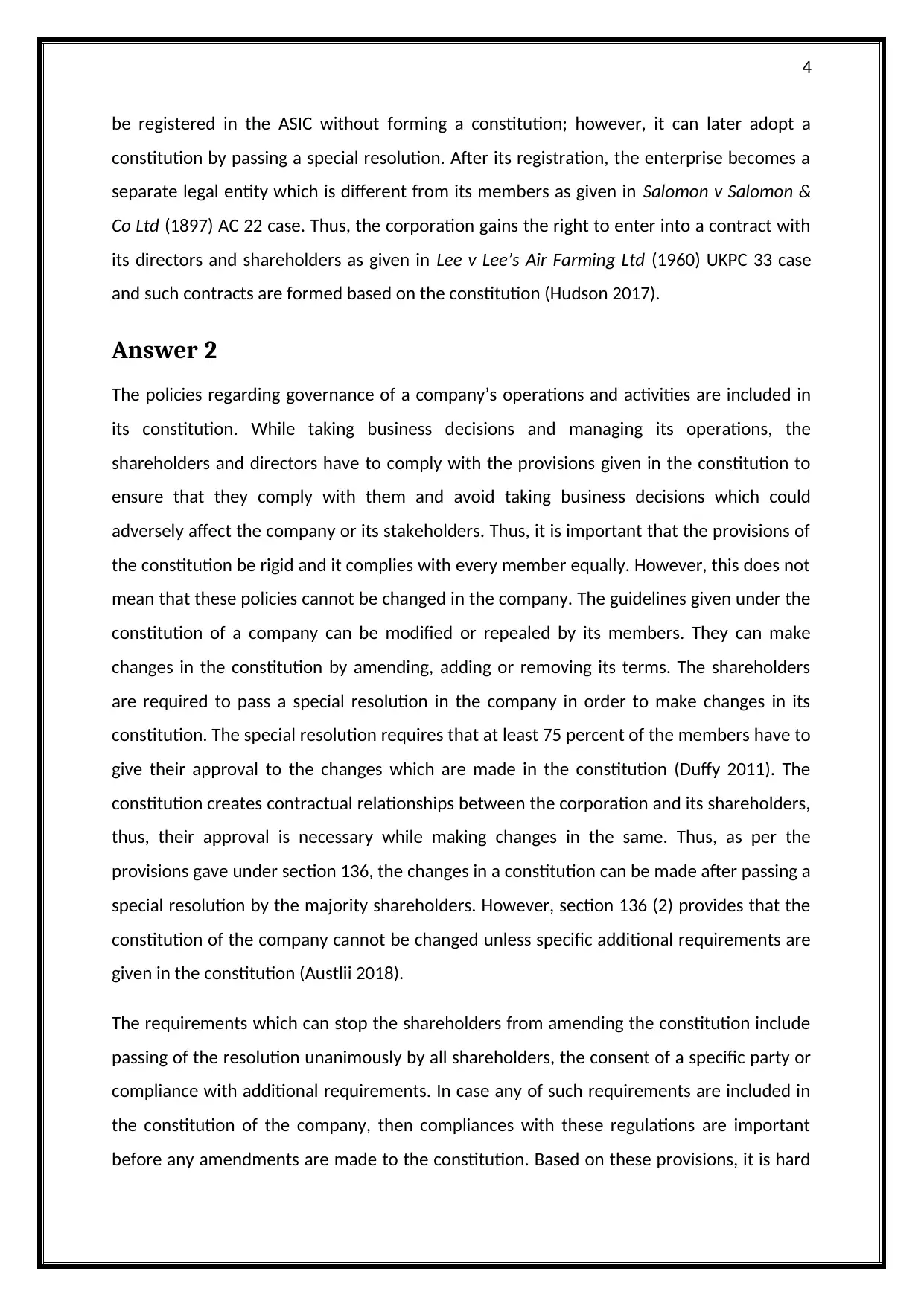
4
be registered in the ASIC without forming a constitution; however, it can later adopt a
constitution by passing a special resolution. After its registration, the enterprise becomes a
separate legal entity which is different from its members as given in Salomon v Salomon &
Co Ltd (1897) AC 22 case. Thus, the corporation gains the right to enter into a contract with
its directors and shareholders as given in Lee v Lee’s Air Farming Ltd (1960) UKPC 33 case
and such contracts are formed based on the constitution (Hudson 2017).
Answer 2
The policies regarding governance of a company’s operations and activities are included in
its constitution. While taking business decisions and managing its operations, the
shareholders and directors have to comply with the provisions given in the constitution to
ensure that they comply with them and avoid taking business decisions which could
adversely affect the company or its stakeholders. Thus, it is important that the provisions of
the constitution be rigid and it complies with every member equally. However, this does not
mean that these policies cannot be changed in the company. The guidelines given under the
constitution of a company can be modified or repealed by its members. They can make
changes in the constitution by amending, adding or removing its terms. The shareholders
are required to pass a special resolution in the company in order to make changes in its
constitution. The special resolution requires that at least 75 percent of the members have to
give their approval to the changes which are made in the constitution (Duffy 2011). The
constitution creates contractual relationships between the corporation and its shareholders,
thus, their approval is necessary while making changes in the same. Thus, as per the
provisions gave under section 136, the changes in a constitution can be made after passing a
special resolution by the majority shareholders. However, section 136 (2) provides that the
constitution of the company cannot be changed unless specific additional requirements are
given in the constitution (Austlii 2018).
The requirements which can stop the shareholders from amending the constitution include
passing of the resolution unanimously by all shareholders, the consent of a specific party or
compliance with additional requirements. In case any of such requirements are included in
the constitution of the company, then compliances with these regulations are important
before any amendments are made to the constitution. Based on these provisions, it is hard
be registered in the ASIC without forming a constitution; however, it can later adopt a
constitution by passing a special resolution. After its registration, the enterprise becomes a
separate legal entity which is different from its members as given in Salomon v Salomon &
Co Ltd (1897) AC 22 case. Thus, the corporation gains the right to enter into a contract with
its directors and shareholders as given in Lee v Lee’s Air Farming Ltd (1960) UKPC 33 case
and such contracts are formed based on the constitution (Hudson 2017).
Answer 2
The policies regarding governance of a company’s operations and activities are included in
its constitution. While taking business decisions and managing its operations, the
shareholders and directors have to comply with the provisions given in the constitution to
ensure that they comply with them and avoid taking business decisions which could
adversely affect the company or its stakeholders. Thus, it is important that the provisions of
the constitution be rigid and it complies with every member equally. However, this does not
mean that these policies cannot be changed in the company. The guidelines given under the
constitution of a company can be modified or repealed by its members. They can make
changes in the constitution by amending, adding or removing its terms. The shareholders
are required to pass a special resolution in the company in order to make changes in its
constitution. The special resolution requires that at least 75 percent of the members have to
give their approval to the changes which are made in the constitution (Duffy 2011). The
constitution creates contractual relationships between the corporation and its shareholders,
thus, their approval is necessary while making changes in the same. Thus, as per the
provisions gave under section 136, the changes in a constitution can be made after passing a
special resolution by the majority shareholders. However, section 136 (2) provides that the
constitution of the company cannot be changed unless specific additional requirements are
given in the constitution (Austlii 2018).
The requirements which can stop the shareholders from amending the constitution include
passing of the resolution unanimously by all shareholders, the consent of a specific party or
compliance with additional requirements. In case any of such requirements are included in
the constitution of the company, then compliances with these regulations are important
before any amendments are made to the constitution. Based on these provisions, it is hard
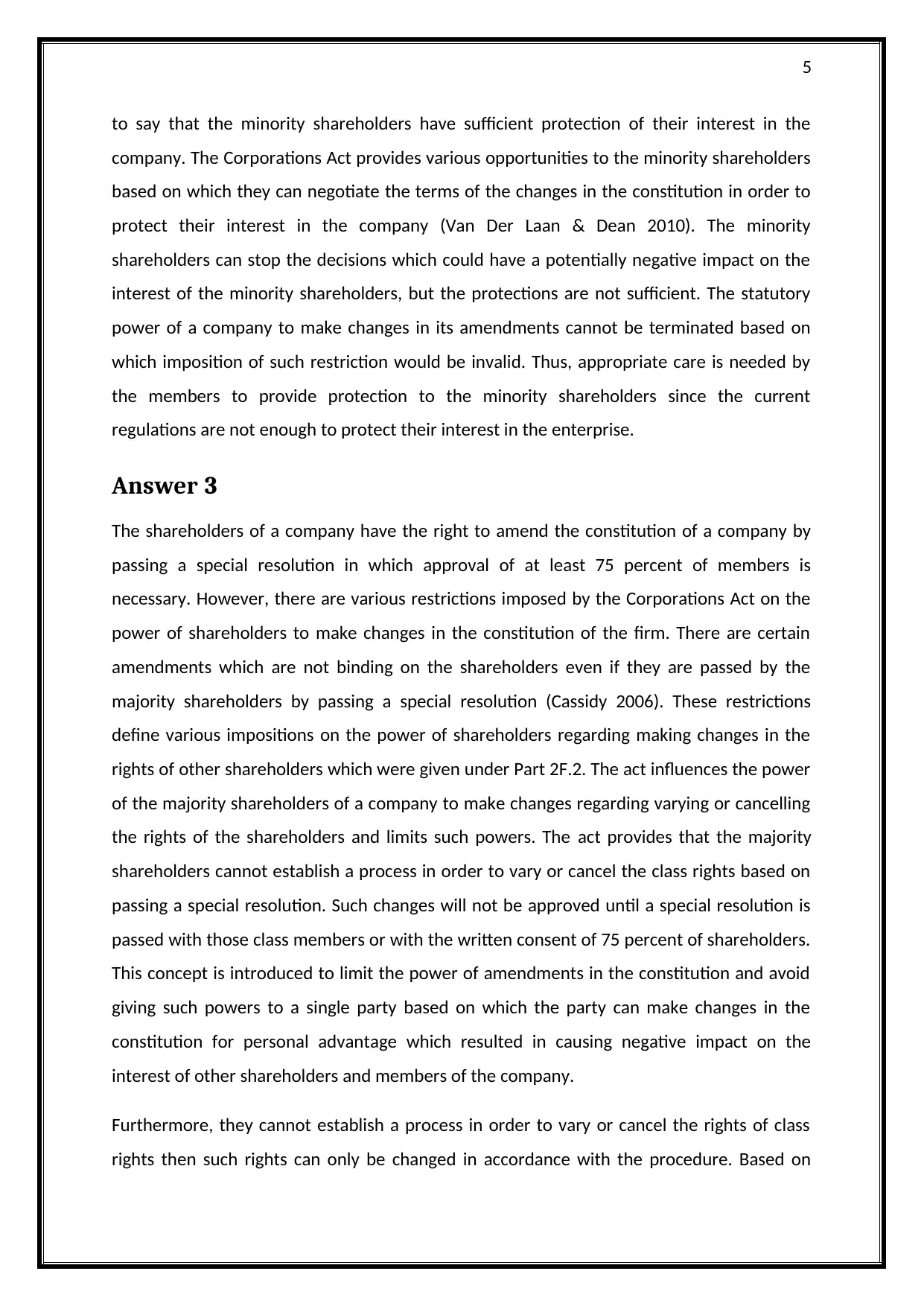
5
to say that the minority shareholders have sufficient protection of their interest in the
company. The Corporations Act provides various opportunities to the minority shareholders
based on which they can negotiate the terms of the changes in the constitution in order to
protect their interest in the company (Van Der Laan & Dean 2010). The minority
shareholders can stop the decisions which could have a potentially negative impact on the
interest of the minority shareholders, but the protections are not sufficient. The statutory
power of a company to make changes in its amendments cannot be terminated based on
which imposition of such restriction would be invalid. Thus, appropriate care is needed by
the members to provide protection to the minority shareholders since the current
regulations are not enough to protect their interest in the enterprise.
Answer 3
The shareholders of a company have the right to amend the constitution of a company by
passing a special resolution in which approval of at least 75 percent of members is
necessary. However, there are various restrictions imposed by the Corporations Act on the
power of shareholders to make changes in the constitution of the firm. There are certain
amendments which are not binding on the shareholders even if they are passed by the
majority shareholders by passing a special resolution (Cassidy 2006). These restrictions
define various impositions on the power of shareholders regarding making changes in the
rights of other shareholders which were given under Part 2F.2. The act influences the power
of the majority shareholders of a company to make changes regarding varying or cancelling
the rights of the shareholders and limits such powers. The act provides that the majority
shareholders cannot establish a process in order to vary or cancel the class rights based on
passing a special resolution. Such changes will not be approved until a special resolution is
passed with those class members or with the written consent of 75 percent of shareholders.
This concept is introduced to limit the power of amendments in the constitution and avoid
giving such powers to a single party based on which the party can make changes in the
constitution for personal advantage which resulted in causing negative impact on the
interest of other shareholders and members of the company.
Furthermore, they cannot establish a process in order to vary or cancel the rights of class
rights then such rights can only be changed in accordance with the procedure. Based on
to say that the minority shareholders have sufficient protection of their interest in the
company. The Corporations Act provides various opportunities to the minority shareholders
based on which they can negotiate the terms of the changes in the constitution in order to
protect their interest in the company (Van Der Laan & Dean 2010). The minority
shareholders can stop the decisions which could have a potentially negative impact on the
interest of the minority shareholders, but the protections are not sufficient. The statutory
power of a company to make changes in its amendments cannot be terminated based on
which imposition of such restriction would be invalid. Thus, appropriate care is needed by
the members to provide protection to the minority shareholders since the current
regulations are not enough to protect their interest in the enterprise.
Answer 3
The shareholders of a company have the right to amend the constitution of a company by
passing a special resolution in which approval of at least 75 percent of members is
necessary. However, there are various restrictions imposed by the Corporations Act on the
power of shareholders to make changes in the constitution of the firm. There are certain
amendments which are not binding on the shareholders even if they are passed by the
majority shareholders by passing a special resolution (Cassidy 2006). These restrictions
define various impositions on the power of shareholders regarding making changes in the
rights of other shareholders which were given under Part 2F.2. The act influences the power
of the majority shareholders of a company to make changes regarding varying or cancelling
the rights of the shareholders and limits such powers. The act provides that the majority
shareholders cannot establish a process in order to vary or cancel the class rights based on
passing a special resolution. Such changes will not be approved until a special resolution is
passed with those class members or with the written consent of 75 percent of shareholders.
This concept is introduced to limit the power of amendments in the constitution and avoid
giving such powers to a single party based on which the party can make changes in the
constitution for personal advantage which resulted in causing negative impact on the
interest of other shareholders and members of the company.
Furthermore, they cannot establish a process in order to vary or cancel the rights of class
rights then such rights can only be changed in accordance with the procedure. Based on
⊘ This is a preview!⊘
Do you want full access?
Subscribe today to unlock all pages.

Trusted by 1+ million students worldwide
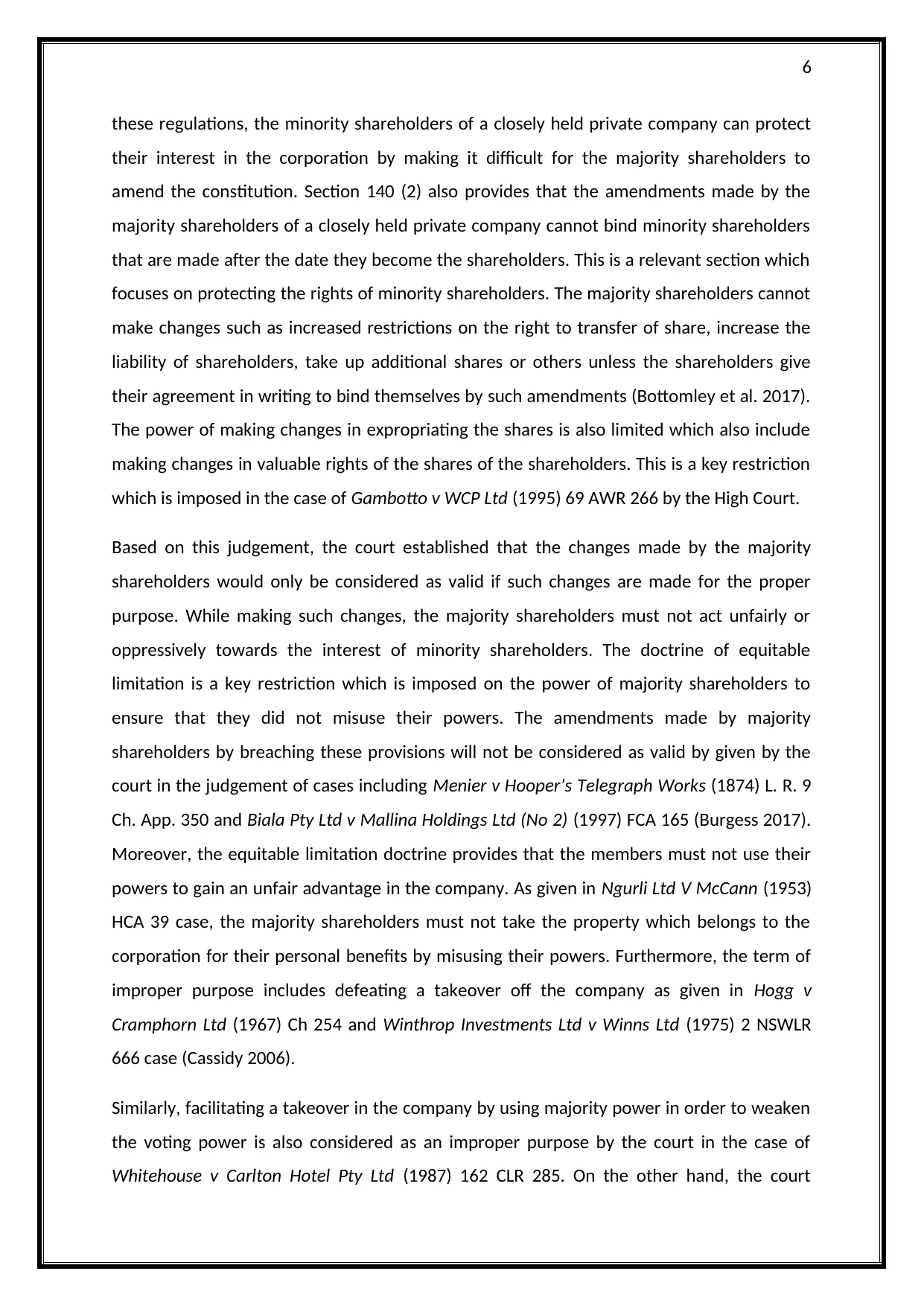
6
these regulations, the minority shareholders of a closely held private company can protect
their interest in the corporation by making it difficult for the majority shareholders to
amend the constitution. Section 140 (2) also provides that the amendments made by the
majority shareholders of a closely held private company cannot bind minority shareholders
that are made after the date they become the shareholders. This is a relevant section which
focuses on protecting the rights of minority shareholders. The majority shareholders cannot
make changes such as increased restrictions on the right to transfer of share, increase the
liability of shareholders, take up additional shares or others unless the shareholders give
their agreement in writing to bind themselves by such amendments (Bottomley et al. 2017).
The power of making changes in expropriating the shares is also limited which also include
making changes in valuable rights of the shares of the shareholders. This is a key restriction
which is imposed in the case of Gambotto v WCP Ltd (1995) 69 AWR 266 by the High Court.
Based on this judgement, the court established that the changes made by the majority
shareholders would only be considered as valid if such changes are made for the proper
purpose. While making such changes, the majority shareholders must not act unfairly or
oppressively towards the interest of minority shareholders. The doctrine of equitable
limitation is a key restriction which is imposed on the power of majority shareholders to
ensure that they did not misuse their powers. The amendments made by majority
shareholders by breaching these provisions will not be considered as valid by given by the
court in the judgement of cases including Menier v Hooper’s Telegraph Works (1874) L. R. 9
Ch. App. 350 and Biala Pty Ltd v Mallina Holdings Ltd (No 2) (1997) FCA 165 (Burgess 2017).
Moreover, the equitable limitation doctrine provides that the members must not use their
powers to gain an unfair advantage in the company. As given in Ngurli Ltd V McCann (1953)
HCA 39 case, the majority shareholders must not take the property which belongs to the
corporation for their personal benefits by misusing their powers. Furthermore, the term of
improper purpose includes defeating a takeover off the company as given in Hogg v
Cramphorn Ltd (1967) Ch 254 and Winthrop Investments Ltd v Winns Ltd (1975) 2 NSWLR
666 case (Cassidy 2006).
Similarly, facilitating a takeover in the company by using majority power in order to weaken
the voting power is also considered as an improper purpose by the court in the case of
Whitehouse v Carlton Hotel Pty Ltd (1987) 162 CLR 285. On the other hand, the court
these regulations, the minority shareholders of a closely held private company can protect
their interest in the corporation by making it difficult for the majority shareholders to
amend the constitution. Section 140 (2) also provides that the amendments made by the
majority shareholders of a closely held private company cannot bind minority shareholders
that are made after the date they become the shareholders. This is a relevant section which
focuses on protecting the rights of minority shareholders. The majority shareholders cannot
make changes such as increased restrictions on the right to transfer of share, increase the
liability of shareholders, take up additional shares or others unless the shareholders give
their agreement in writing to bind themselves by such amendments (Bottomley et al. 2017).
The power of making changes in expropriating the shares is also limited which also include
making changes in valuable rights of the shares of the shareholders. This is a key restriction
which is imposed in the case of Gambotto v WCP Ltd (1995) 69 AWR 266 by the High Court.
Based on this judgement, the court established that the changes made by the majority
shareholders would only be considered as valid if such changes are made for the proper
purpose. While making such changes, the majority shareholders must not act unfairly or
oppressively towards the interest of minority shareholders. The doctrine of equitable
limitation is a key restriction which is imposed on the power of majority shareholders to
ensure that they did not misuse their powers. The amendments made by majority
shareholders by breaching these provisions will not be considered as valid by given by the
court in the judgement of cases including Menier v Hooper’s Telegraph Works (1874) L. R. 9
Ch. App. 350 and Biala Pty Ltd v Mallina Holdings Ltd (No 2) (1997) FCA 165 (Burgess 2017).
Moreover, the equitable limitation doctrine provides that the members must not use their
powers to gain an unfair advantage in the company. As given in Ngurli Ltd V McCann (1953)
HCA 39 case, the majority shareholders must not take the property which belongs to the
corporation for their personal benefits by misusing their powers. Furthermore, the term of
improper purpose includes defeating a takeover off the company as given in Hogg v
Cramphorn Ltd (1967) Ch 254 and Winthrop Investments Ltd v Winns Ltd (1975) 2 NSWLR
666 case (Cassidy 2006).
Similarly, facilitating a takeover in the company by using majority power in order to weaken
the voting power is also considered as an improper purpose by the court in the case of
Whitehouse v Carlton Hotel Pty Ltd (1987) 162 CLR 285. On the other hand, the court
Paraphrase This Document
Need a fresh take? Get an instant paraphrase of this document with our AI Paraphraser
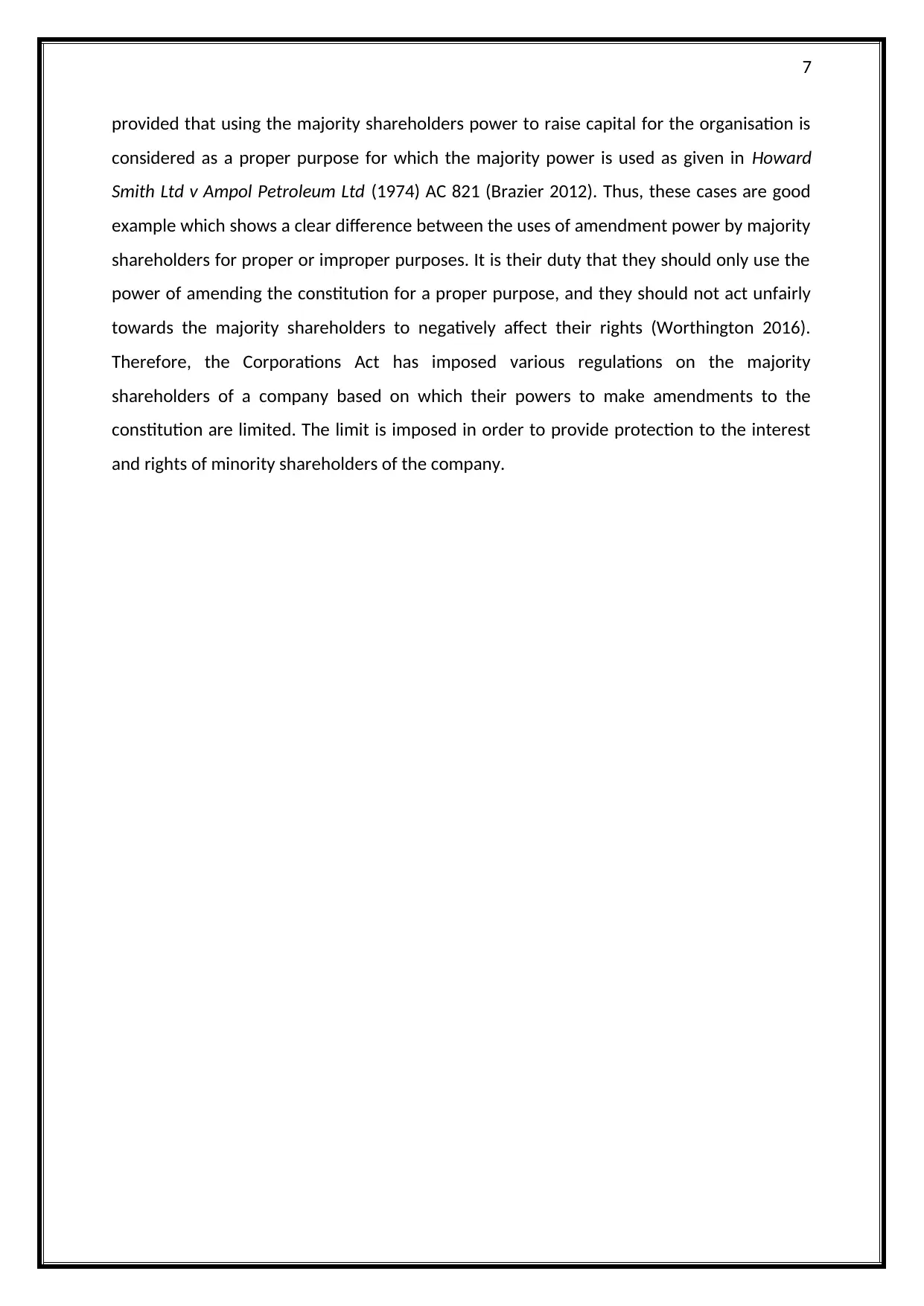
7
provided that using the majority shareholders power to raise capital for the organisation is
considered as a proper purpose for which the majority power is used as given in Howard
Smith Ltd v Ampol Petroleum Ltd (1974) AC 821 (Brazier 2012). Thus, these cases are good
example which shows a clear difference between the uses of amendment power by majority
shareholders for proper or improper purposes. It is their duty that they should only use the
power of amending the constitution for a proper purpose, and they should not act unfairly
towards the majority shareholders to negatively affect their rights (Worthington 2016).
Therefore, the Corporations Act has imposed various regulations on the majority
shareholders of a company based on which their powers to make amendments to the
constitution are limited. The limit is imposed in order to provide protection to the interest
and rights of minority shareholders of the company.
provided that using the majority shareholders power to raise capital for the organisation is
considered as a proper purpose for which the majority power is used as given in Howard
Smith Ltd v Ampol Petroleum Ltd (1974) AC 821 (Brazier 2012). Thus, these cases are good
example which shows a clear difference between the uses of amendment power by majority
shareholders for proper or improper purposes. It is their duty that they should only use the
power of amending the constitution for a proper purpose, and they should not act unfairly
towards the majority shareholders to negatively affect their rights (Worthington 2016).
Therefore, the Corporations Act has imposed various regulations on the majority
shareholders of a company based on which their powers to make amendments to the
constitution are limited. The limit is imposed in order to provide protection to the interest
and rights of minority shareholders of the company.
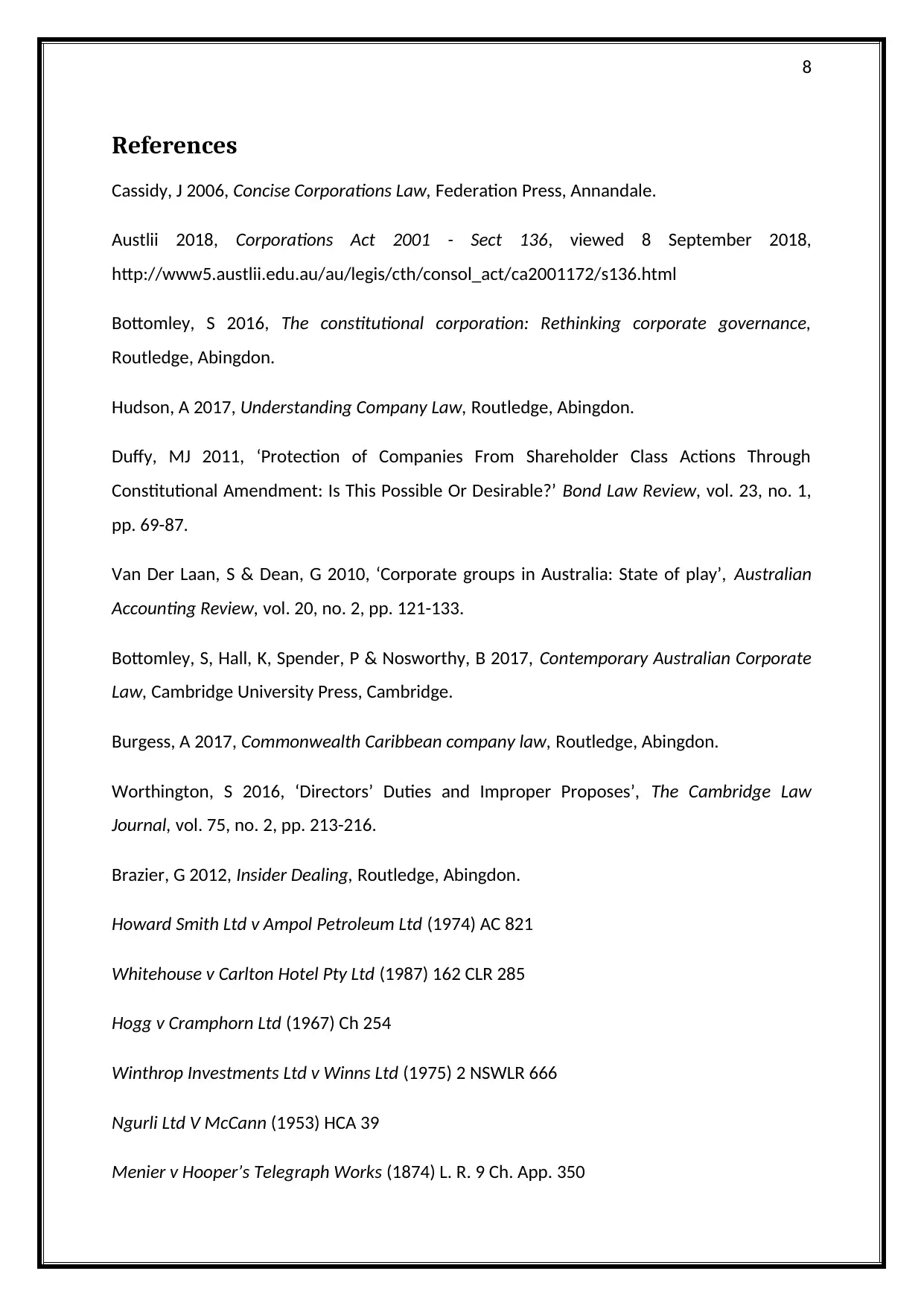
8
References
Cassidy, J 2006, Concise Corporations Law, Federation Press, Annandale.
Austlii 2018, Corporations Act 2001 - Sect 136, viewed 8 September 2018,
http://www5.austlii.edu.au/au/legis/cth/consol_act/ca2001172/s136.html
Bottomley, S 2016, The constitutional corporation: Rethinking corporate governance,
Routledge, Abingdon.
Hudson, A 2017, Understanding Company Law, Routledge, Abingdon.
Duffy, MJ 2011, ‘Protection of Companies From Shareholder Class Actions Through
Constitutional Amendment: Is This Possible Or Desirable?’ Bond Law Review, vol. 23, no. 1,
pp. 69-87.
Van Der Laan, S & Dean, G 2010, ‘Corporate groups in Australia: State of play’, Australian
Accounting Review, vol. 20, no. 2, pp. 121-133.
Bottomley, S, Hall, K, Spender, P & Nosworthy, B 2017, Contemporary Australian Corporate
Law, Cambridge University Press, Cambridge.
Burgess, A 2017, Commonwealth Caribbean company law, Routledge, Abingdon.
Worthington, S 2016, ‘Directors’ Duties and Improper Proposes’, The Cambridge Law
Journal, vol. 75, no. 2, pp. 213-216.
Brazier, G 2012, Insider Dealing, Routledge, Abingdon.
Howard Smith Ltd v Ampol Petroleum Ltd (1974) AC 821
Whitehouse v Carlton Hotel Pty Ltd (1987) 162 CLR 285
Hogg v Cramphorn Ltd (1967) Ch 254
Winthrop Investments Ltd v Winns Ltd (1975) 2 NSWLR 666
Ngurli Ltd V McCann (1953) HCA 39
Menier v Hooper’s Telegraph Works (1874) L. R. 9 Ch. App. 350
References
Cassidy, J 2006, Concise Corporations Law, Federation Press, Annandale.
Austlii 2018, Corporations Act 2001 - Sect 136, viewed 8 September 2018,
http://www5.austlii.edu.au/au/legis/cth/consol_act/ca2001172/s136.html
Bottomley, S 2016, The constitutional corporation: Rethinking corporate governance,
Routledge, Abingdon.
Hudson, A 2017, Understanding Company Law, Routledge, Abingdon.
Duffy, MJ 2011, ‘Protection of Companies From Shareholder Class Actions Through
Constitutional Amendment: Is This Possible Or Desirable?’ Bond Law Review, vol. 23, no. 1,
pp. 69-87.
Van Der Laan, S & Dean, G 2010, ‘Corporate groups in Australia: State of play’, Australian
Accounting Review, vol. 20, no. 2, pp. 121-133.
Bottomley, S, Hall, K, Spender, P & Nosworthy, B 2017, Contemporary Australian Corporate
Law, Cambridge University Press, Cambridge.
Burgess, A 2017, Commonwealth Caribbean company law, Routledge, Abingdon.
Worthington, S 2016, ‘Directors’ Duties and Improper Proposes’, The Cambridge Law
Journal, vol. 75, no. 2, pp. 213-216.
Brazier, G 2012, Insider Dealing, Routledge, Abingdon.
Howard Smith Ltd v Ampol Petroleum Ltd (1974) AC 821
Whitehouse v Carlton Hotel Pty Ltd (1987) 162 CLR 285
Hogg v Cramphorn Ltd (1967) Ch 254
Winthrop Investments Ltd v Winns Ltd (1975) 2 NSWLR 666
Ngurli Ltd V McCann (1953) HCA 39
Menier v Hooper’s Telegraph Works (1874) L. R. 9 Ch. App. 350
⊘ This is a preview!⊘
Do you want full access?
Subscribe today to unlock all pages.

Trusted by 1+ million students worldwide
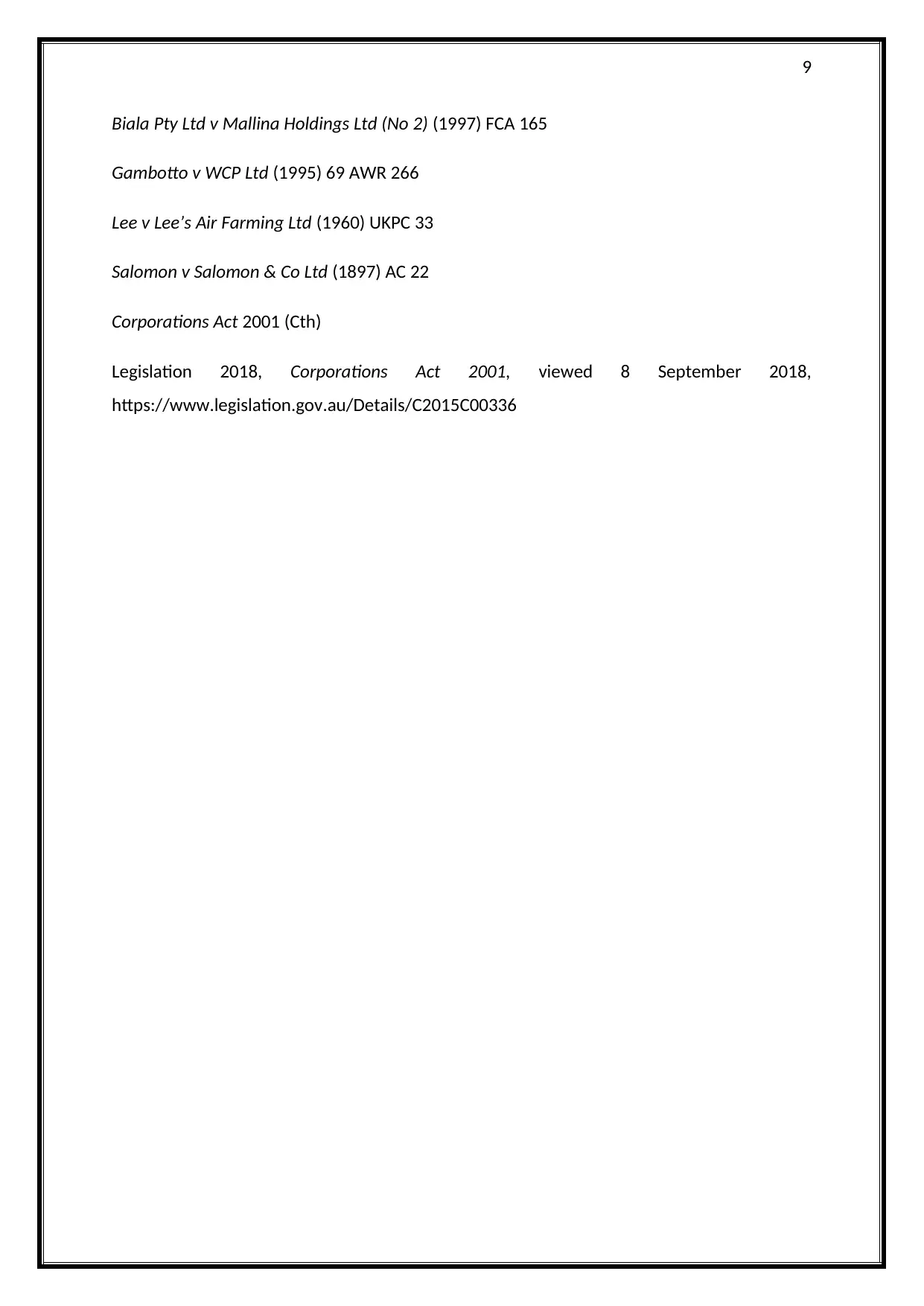
9
Biala Pty Ltd v Mallina Holdings Ltd (No 2) (1997) FCA 165
Gambotto v WCP Ltd (1995) 69 AWR 266
Lee v Lee’s Air Farming Ltd (1960) UKPC 33
Salomon v Salomon & Co Ltd (1897) AC 22
Corporations Act 2001 (Cth)
Legislation 2018, Corporations Act 2001, viewed 8 September 2018,
https://www.legislation.gov.au/Details/C2015C00336
Biala Pty Ltd v Mallina Holdings Ltd (No 2) (1997) FCA 165
Gambotto v WCP Ltd (1995) 69 AWR 266
Lee v Lee’s Air Farming Ltd (1960) UKPC 33
Salomon v Salomon & Co Ltd (1897) AC 22
Corporations Act 2001 (Cth)
Legislation 2018, Corporations Act 2001, viewed 8 September 2018,
https://www.legislation.gov.au/Details/C2015C00336
1 out of 10
Related Documents
Your All-in-One AI-Powered Toolkit for Academic Success.
+13062052269
info@desklib.com
Available 24*7 on WhatsApp / Email
![[object Object]](/_next/static/media/star-bottom.7253800d.svg)
Unlock your academic potential
Copyright © 2020–2025 A2Z Services. All Rights Reserved. Developed and managed by ZUCOL.




